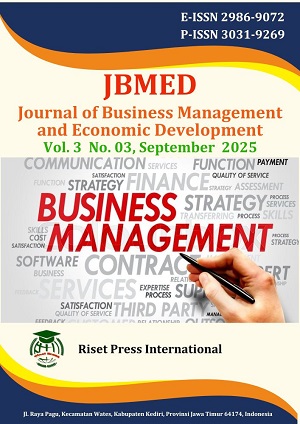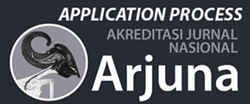Effect of Inflation, Interest Rates, and NIKKEI 225 Index on Composite Stock Price Index in the Capital Markets of 9 ASEAN Countries 2019-2023
DOI:
https://doi.org/10.59653/jbmed.v3i03.1830Keywords:
Consumer Price Index, Interest Rates, capital indexAbstract
This research investigates the influence of inflation, interest rates, and the Nikkei 225 index on the Composite Stock Price Index (IHSG) within the capital markets of nine ASEAN nations over the period from 2019 to 2023. A total of 45 data points were selected using purposive sampling techniques to ensure relevance and alignment with the study objectives. The data analysis was conducted utilizing multiple linear regression methods with a panel data approach, processed through Eviews 12 software. The analytical procedures encompassed a comprehensive range of tests, including descriptive statistical analysis, panel regression estimation, hypothesis testing, and classical assumption diagnostics such as normality, multicollinearity, and heteroscedasticity assessments. The findings from the t-test indicate that both inflation and interest rate variables do not exert a statistically significant influence on the IHSG, whereas the Nikkei 225 index demonstrates a significant and positive effect. Moreover, the results of the F-test reveal that, when evaluated collectively, the three independent variables significantly affect the IHSG across the observed ASEAN countries.
Downloads
References
Aditya, A., Sinaga, B. M., & Maulana, T. A. (2018). Pengaruh Indeks Bursa Luar Negeri, Indikator Makroekonomi dan Krisis Ekonomi Global Terhadap Indeks Harga Saham Gabungan di Indonesia. Jurnal Aplikasi Bisnis Dan Manajemen, 4(2), 284–295. https://doi.org/10.17358/jabm.4.2.284
Anoraga, P., & Pakarti, P. (2003). Pengantar pasar modal / Pandji Anoraga, Piji Pakarti (Ed. Rev ;). Rineka Cipta. https://inlislite.uin-suska.ac.id/opac/detail-opac?id=19263
Astuti, R. W. (2021). Pengaruh Variabel Makro Terhadap Indeks Harga Saham Gabungan (Ihsg) Di 5 Negara Asean. Jurnal Ekonomi Dan Kajian Keislaman, 1(2), 24–35. https://download.garuda.kemdikbud.go.id/article
Azzahra, I. S. (2023). Analisis Pengaruh Inflasi Dan Suku Bunga Terhadap Velocity Of Money Di Tiga Negara Asean Sebelum Dan Selama Pandemi Covid 19. Nucl. Phys., 13(1), 104–116.
Citra Asmara, T., Desmintari, D., & Arrafi Juliannisa, I. (2022). Faktor–Faktor yang Mempengaruhi Indeks Harga Saham Gabungan. Jurnal Indonesia Sosial Sains, 3(05), 822–834. https://doi.org/10.59141/jiss.v3i05.590
Climent, F., & Meneu, V. (2003). Has 1997 Asian crisis increased information flows between international markets. International Review of Economics & Finance, 12(1), 111–143. https://doi.org/10.1016/s1059-0560(02)00140-5
Darwati, S., & Santoso, N. T. (2014). Pengaruh Perubahan Nilai Tukar, Suku Bunga, Harga Minyak Dunia dan Indeks Saham Dow Jones Terhadap Indeks Harga Saham Gabungan Pada Pasar Modal di Negara-Negara Asean. The 7th NCFB and Doctoral Colloquium 2014 Towards a New Indonesia Business Architecture Sub Tema: “Business And Economic Transformation Towards AEC 2015” Fakultas Bisnis Dan Pascasarjana UKWMS, 47–56. https://www.researchgate.net/publication/326300524_Pengaruh_Perubahan_Nilai_Tukar_Suku_Bunga_Harga_Minyak_Dunia_Dan_Indeks_Saham_Dow_Jones_Terhadap_Indeks_Harga_Saham_Gabungan_Pada_Pasar_Modal_Di_Negara-Negara_Asean
Desfiandi, A., Desfiandi, A., & Ali, H. (2017). International Journal of Economics and Financial Issues Composite Stock Price Index (IHSG) Macro Factor in Investment in Stock (Equity Funds). International Journal of Economics and Financial Issues, 7(3), 534–536. http:www.econjournals.com
Ersabathari, R. V., & Muharam, H. (2017). Integrasi Pasar Modal ASEAN 6 Periode 2016-2017. Diponegoro Journal of Management, 6(3), 1–15. http://ejournal-s1.undip.ac.id/index.php/dbr
Ginanjar, W. R., & Maksum, A. (2022). The Political Dynamics of Southeast Asia and the Identity Transformation of ASEAN in Post-Cold War and Post-Economic Crisis 1997-1998. JISPO Jurnal Ilmu Sosial Dan Ilmu Politik, 12(1), 81–104. https://doi.org/10.15575/jispo.v12i1.15766
Gunarti, T. S. (2018). Nilai Tukar Terhadap Return Saham Sektor Properti. 1–12.
Gunawan, J. L. (2024). Pengaruh Inflasi, Suku Bunga Sbi, Pdb Dan Nilai Tukar Terhadap Indeks Harga Saham Gabungan (Ihsg) Di Bursa Efek Indonesia Tahun 2000-2014. Arthavidya Jurnal Ilmiah Ekonomi, 19(2), 1–15.
Herlianto, D., & Hafizh, L. (2020). Pengaruh Indeks Dow Jones, Nikkei 225, Shanghai Stock Exchange, Dan Straits Times Index Singapore Terhadap Indeks Harga Saham Gabungan (IHSG) Di Bursa Efek Indonesia (BEI). INOBIS: Jurnal Inovasi Bisnis Dan Manajemen Indonesia, 3(2), 211–229. https://doi.org/10.31842/jurnalinobis.v3i2.133
Kristanto, M. E., & Ideis. (2016). Terhadap Pergerakan Bersama Return Saham Ihsg Dan Volume Perdagangan Periode Januari 2006 – Desember 2015. 5, 1–15. http://ejournal-s1.undip.ac.id/index.php/management
Kurniasih, E. P. (2020). Perkembangan investasi asing di negara ASEAN. In Seminar Akademik Tahunan Ilmu Ekonomi Dan Studi Pembangunan. 362–370. https://feb.untan.ac.id/wp-content/uploads/2020/12/Erni-2.
Maharani, F. A. T., Yuliani, Y., Malinda, S., & Andriana, I. (2024). Pengaruh Inflasi, Nilai Tukar, Dan Suku Bunga Terhadap Indeks Harga Saham Di Kawasan Asean Periode 2010-2022. Jurnal Ekonomi Manajemen Sistem Informaasi (JEMSI), 5(2), 163–177. https://doi.org/10.31933/jemsi.v5i6
Martina, F. A. (2021). Saham, Harga Kawasan, D I Periode, Asean. 5(2), 163–177. https://jsmk.ulm.ac.id/index.php/jsmk/index
Nurdin, F. S. (2022). Diskursus Urgensi Sosiologi Hukum. Transformatif, 10(2), 65. https://doi.org/10.58300/transformatif.v10i2.215
Nurhayati, M. (2012). Analisis Integrasi Pasar Modal Kawasan ASEAN dalam Rangka Menuju Masyarakat Ekonomi ASEAN. Seminar Nasional Dan Call for …, 1–15. http://eprints.unisbank.ac.id/205/
Nurkhikmatul Aini, I., Wardani, M. K., Rika, Amalia, Z., & Afridayani. (2020). Pengaruh Inflasi, Nilai Tukar Rupiah dan Tingkat Suku Bunga terhadap Indeks Harga Saham Gabungan. Prosiding Webinar “Insentif Pajak Untuk WP Terdampak Covid-19,” 135–145. http://openjournal.unpam.ac.id/index.php/Proceedings/article/view/9949.
Putri, A. R. (2018). Pengaruh Solvabilitas, Likuiditas, Profitabilitas Terhadap Harga Saham Pada Sektor Farmasi Yang Terdaftar Di Bei. Jurnal Ilmu Dan Riset Manajemen, 1(2), 2. https://jurnalmahasiswa.stiesia.ac.id/index.php/jirm/article/view/5853
Rohmawati, Y., & Zuhroh, I. (2019). Pengaruh Inflasi, Nilai Tukar, Suku Bunga Dan Indeks Nikkei 225 Terhadap Indeks Harga Saham Gabungan Di Asean. Jurnal Ilmu Ekonomi (JIE), 3(3), 467–480.
Sanida, N. (2021). Determinan Inflasi Di Negara-Negara Asean-5 (Indonesia, Malaysia, Philippines, Thailand, Dan Vietnam). 5.
Soekapdjo, S., & Maria esther, A. (2019). Determinasi Pertumbuhan Ekonomi Berkelanjutan Di Asean-3. Jurnal Ilmiah Ekonomi Dan Bisnis, 16(2), 176–182. https://doi.org/10.31849/jieb.v16i2.2978
Suganda, T. R. (2018). Event Study : “Teori dan Pembahasan Reaksi Pasar Modal Indonesia.” In Angewandte Chemie International Edition, 6(11), 951–952. (Issue November). https://www.researchgate.net/publication/341915291%0AEvent
Sugiyono. (2017). Metode Penelitian Kuantitatif Kualitatif dan R&D. Alfabeta Bandung. https://scholar.google.com/citations?user=MGOs5rkAAAAJ&hl=id
Sundoro, H. S., & Theovardo, T. (2019). Analisis Kointegrasi Pasar Modal Indonesia Dengan Pasar Modal Pada Negara-Negara Asean Selama Era Mea. AKURASI: Jurnal Riset Akuntansi Dan Keuangan, 1(2), 99–110. https://doi.org/10.36407/akurasi.v1i2.119
Tambunan Novyanti, R. S. A. (2021). Pengaruh Inflasi, Suku Bunga Sbi , Dan Kurs Terhadap Indeks Harga Saham Gabungan. Jurnal Akuntansi, Keuangan, Pajak Dan Informasi (JAKPI), 2(2), 160–180. https://doi.org/10.32509/jakpi.v2i2.2474
Virby, S. (2013). Pengaruh Indeks Dow Jones Industrial Average, Nikkei 225, Hangseng Index, Dan Shanghai Stock Exchange Terhadap Indeks Harga Saham Gabungan Bursa Efek Indonesia Periode Tahun 2008-2013. 79–99. https://openjournal.unpam.ac.id
Wardhono, A., Qori’ah, C. G., Nasir, M. A., & Aprilia, A. (2020). Analisis Dampak Indikator Makroekonomi terhadap Investasi Portofolio di ASEAN 4. Jurnal Ekonomi Indonesia, 9(1), 81–97. https://doi.org/10.52813/jei.v9i1.43
Wismantara, S. Y., & Darmayanti, N. P. A. (2017). Pengaruh Nilai Tuker, Suku Bunga, dan Inflasi Terhadap Harga Saham di Bursa Efek Indonesia. E-Jurnal Manajemen Universitas Udayana, 6(8), 4391–4421. https://www.neliti.com/id/publications/254963/pengaruh-nilai-tukar-suku-bunga-dan-inflasi-terhadap-indeks-harga-saham-gabungan
Wulandari, D. D., Puspitasari, N., & Mufida, A. (2020). Pengaruh Inflasi, Nilai Tukar, Dan Suku Bunga Terhadap Indeks Harga Saham Gabungan Di Bursa Efek Negara-Negara ASEAN. Relasi : Jurnal Ekonomi, 16(1), 164–178. https://doi.org/10.31967/relasi.v16i1.346
Zilamsari, N., Ilmi, Z., & Nadir, M. (2017). Pengaruh Inflasi, Kurs, Indeks Dow Jones dan Indeks Nikkei 225 Terhadap Indeks Harga Saham Gabungan (IHSG) Di Bursa Efek Indonesia (BEI) Pada Periode 2011-2015 The Effects of Inflation, Exchange, Dow Jones Index and Nikkei 225 Index on Composite Stock Pri. Prosiding Seminar Nasional Manajemen Dan Ekonomi Bisnis, 1, 453–460. http://journal.feb.unmul.ac.id/index.php/Prosnmeb
Downloads
Published
How to Cite
Issue
Section
License
Copyright (c) 2025 Fransiskus Pawang Ismono, Suripto, Damayanti

This work is licensed under a Creative Commons Attribution-ShareAlike 4.0 International License.
Authors who publish with this journal agree to the following terms:
- Authors retain copyright and grant the journal right of first publication with the work simultaneously licensed under a Creative Commons Attribution-ShareAlike that allows others to share the work with an acknowledgement of the work's authorship and initial publication in this journal.
- Authors are able to enter into separate, additional contractual arrangements for the non-exclusive distribution of the journal's published version of the work (e.g., post it to an institutional repository or publish it in a book), with an acknowledgement of its initial publication in this journal.
- Authors are permitted and encouraged to post their work online (e.g., in institutional repositories or on their website) prior to and during the submission process, as it can lead to productive exchanges, as well as earlier and greater citation of published work (See The Effect of Open Access).





























